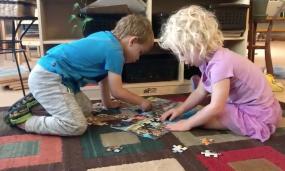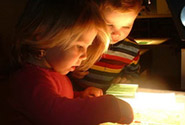Camden and Olivia do a Puzzle

When children solve a jigsaw puzzle they use various strategies to improve their “hit rate”, finding pieces that fit the appropriate spaces. They lift a piece, look at it, and then visually scan the incomplete puzzle for similar colors, recognizable object parts, or vacant spaces that are compatible with that piece. This is called "piece fitting" where the child seeks information from the piece before looking at the table. In piece fitting children also try one piece in several places before discarding or fitting the piece. Alternatively, children might look at the incomplete puzzle, see the contour of an empty space or a recognizable part of the picture of an incomplete object and then visually scan the loose pieces for one that could complete the object, color, or empty space. This is called "space filling." Also in space filling children try several different pieces successively in the same space. With puzzle pieces that are basically the same general shape (two or three pips with one or two notches), looking at the empty contour of the spaces on the table or the contour of the piece held in the hand will not be very successful. However, when a space becomes well-defined, as happens when all the surrounding pieces have been placed, then looking over the physical contour of the loose pieces to find a match for the well-defined empty space could work.
Reading the included action transcript of Camden and Olivia, we note that they know this animal’s picture rather well, and they begin by searching the loose pieces for pieces that match colors and partial objects in a completed region (piece fitting). This strategy reduces false selections. However, when the space is well-defined, as happens toward the completion of the puzzle, they shift to looking for a piece with the same contour as the hole. We know from previous research that the physical contour of pieces generally is not used unless adjacent pieces have just one color or very little interior details for objects.
Of note, we see that both children often rotate a piece to its correct orientation even before that piece is near the space it belongs, suggesting that they have already encoded the match between piece and space. We also note that Camden on three occasions could have used, but did not use, the fact that a piece had a straight edge. Finding all of the edge pieces first can define the border of a puzzle rather efficiently. But the straight edges seem to have less implication for Camden than does the color, object detail, and interlocking pips and notches. There is no evidence of the edge strategy in the moves by Olivia in this video segment. A careful reading of the action transcript will reveal other strategies that represent the children’s high level thinking.
We have added a verbal transcript as an addendum to the action transcript. Use this verbal transcript to study the social dynamic between two children who have long been friends. We encourage you to think about how this history of friendship might contribute to their ability to sustain constructive play together, including their respect for a division of labor and knowledge of each other's style.
